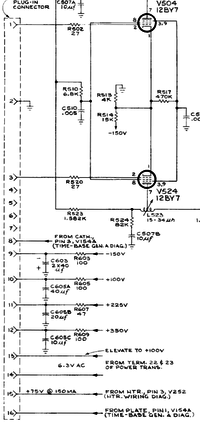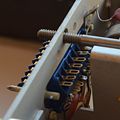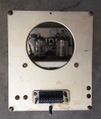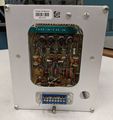500 Series plug-in interface

The plug-in interface of the 500-series scopes is a single 16-pin Amphenol connector.
Pin-out
Pin group function legend
|
Signal Input Impedance and Spoiler Switch HoleThe input impedance of 500-series scopes presented to the plug-in at pins 1+3 is approximately kept constant by adding shunt capacitors at the input depending on the tube type used. Early, scopes like the 536 and the 555 use a 12BY7 differential amplifier in the input stage, and the plug-in is loaded with the grid input capacitance with 2x 27 Ω (555) or 47 Ω (536) in series. Later, medium speed scopes like the 545B and the 549 use dual input followers with a 6DJ8 tubes and 2x 47 Ω in series at the grids, so to keep the plug-in loading approximately constant a 3.9 pF capacitor is placed across pins 1 and 3 in the scope. High-speed scopes designed for 1-series plug-ins and up to 50 MHz bandwidth use a even lower input capacitance dual follower implemented with 12AT7s and series grid resistors of 22 Ω. For compatibility with older plugins designed for a higher capacitive load a series network of 7.5 pF and 82 Ω is shunted accross pins 1 and 3 by means of a switch. This spoiler switch is activated by all slower letter plugins. High speed plugins like the 1A1 have a hole in the back plate to allow for the switch plunger to pass through and access the full system bandwidth of the scope. Scopes and adapters known to use this spoiler switch are the 544, 546, 547, 556, and the 81A.
Internal Trigger signalIn early 500-series systems (e.g., a Type C plug-in in a 535 mainframe), the mainframe's triggering is based on the main vertical signal (pins 1/3). In these scopes, changing the vertical position control on the plug-in interacts with the trigger level setting if the scope is set to a DC trigger mode. In somewhat later 500-series systems (e.g. Type 547), the plug-in (e.g. Type 1A1) provides the mainframe with a separate trigger signal on pin 5 whose DC level is not affected by the vertical position knob. In multi-trace setups, this allows consistent triggering from a specific input channel independent of which channel is currently being drawn on CRT. For backward compatibility, the 547-era scopes have two types of INT triggering, taking the trigger signal either from the main vertical plug-in output (1/3), or the trigger output (5). Although the Type 1A1 has two input channels, they are not identical - the pin 5 internal trigger signal is always taken from channel 1. Even later 500-series plug-ins (e.g., the Type 1A4), have a knob for the selection of which input channel's signal supplies the trigger signal. |
Pictures
-
pinout shown in 556 schematic
-
pinout listed in 040-0065-00 kit docs
-
pinout shown in 1A2 schematic
-
544 vertical amplifier input with spoiler switch SW1000
-
Male pins on plugin
-
Rear lugs on plugin
-
Back plate of K plug-in without spoiler hole
-
Back plate of 1A1 plug-in with spoiler hole (circular hole right of 16-pin Amphenol connector)







